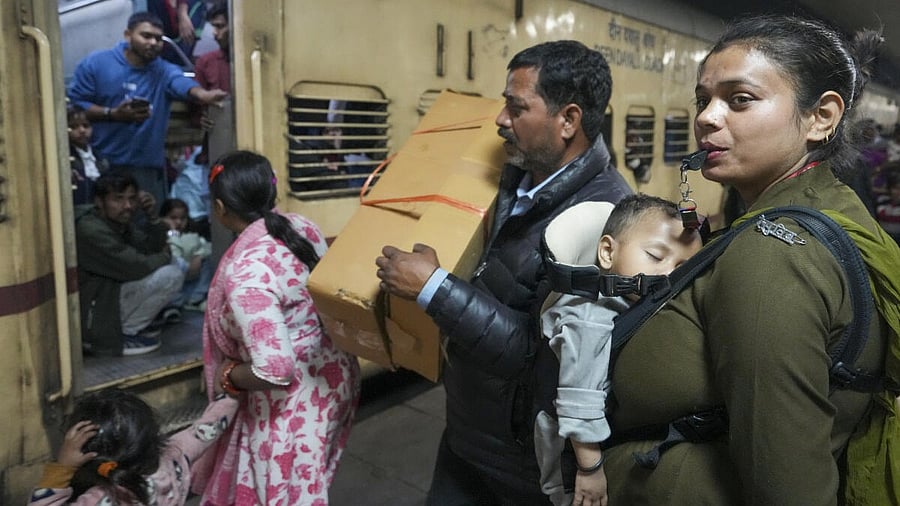
A RPF official carrying her child manages a crowd of passengers at the New Delhi Railway Station, in New Delhi, Sunday, Feb. 16, 2025. At least 18 people were killed and more than a dozen injured in a stampede that broke out late Saturday night at the crowded railway station in the national capital.
Credit: PTI Photo
Past mistakes can inform the present and help prepare for the future. In disaster management, learnings from the past play a critical role in this preparedness. With Indian Railways, however, it is a different story. In 2013, a stampede at the Allahabad railway station during the Maha Kumbh had claimed more than 40 lives. Three years earlier, two people died in a stampede at the New Delhi station – a change in platform schedules triggered the stampede.
The New Delhi railway station stampede on February 15 which claimed 18 lives including 11 women and three children defies reason. It is not that the Kumbh rush happened only on that fateful day; crowds had been gathering and travelling for over a month by then. According to preliminary findings, the incident took place at 8.49 pm on the stairs of a foot overbridge connecting platforms 14 and 15, where a large crowd had gathered to board trains heading to Prayagraj. The Railways has maintained that to meet surging traffic to Prayagraj, a special train was announced from platform 12. As many people were rushing to platform 12 to board the Prayagraj Special, some of them, with their baggage, fell on the stairs and triggered the stampede.
However, eyewitnesses said the stampede was not restricted to the stairs and was spread over the platform. The porters were the first to join the rescue act before the Railways medical staff were pressed into service. The Railways maintain that all precautions were in place to handle the large crowds with adequate numbers of additional trains and personnel but CCTV footage revealed that neither RPF personnel nor the Railways’ commercial staff were present at the site of the stampede.
A combination of factors appears to have contributed to the mishap but what stand out as glaring are flawed, unscientific crowd management, and poor coordination among the officials. The fact of the matter is that traffic towards Prayagraj was increasing – on rail and road routes – from the beginning of February with improvement in weather. Besides crowding at the main stations, there was a significant increase in the number of passengers on waiting lists as well as queues outside the ticketing windows.
It appears that Northern Railway, specifically the Delhi Division, which is no stranger to this kind of crowd during the Holi and Chhat festivals, was far from ready for the surge in numbers. It is to be noted that a war room for the Kumbh created at the Railway Board with much fanfare – to be manned by senior officials round the clock – could not prevent the stampede. CCTV footage from multiple stations is screened live, enabling senior officials to direct the staff on the ground to do the needful during emergencies. However, it appears that the monitoring teams were too focused on Prayagraj and the adjoining stations to notice the crowd building up in New Delhi. A prompt alert on this build-up could have averted the stampede.
To facilitate as many passengers as possible for the Kumbh, the Railways allowed continuous sale of general category tickets without the necessary caution. As a result, 2,600 tickets were sold in only an hour which increased the burden on the already stretched infrastructure. Though the Railways denied bunching of other mail/express trains to allow Prayagraj-bound services to move first, many trains were reported as delayed, leading to more rush at the station.
The redistribution of trains from originating stations in the NCR should have commenced during this period. Some of the special trains could have been directed to stations like Old Delhi, Nizamuddin, Safdarjung, Gurugram, Bijvasan, Palwal, and Sonipat to decongest the crowd at New Delhi. Instead, the majority of trains were concentrated at New Delhi and Anand Vihar, thereby increasing passenger footfall to unmanageable levels.
The incident underscores the need for better crowd management and coordination, with a critical focus on scientific planning which enables on-the-spot decisions and site arrangements. In the aftermath of the tragedy, the Railways has firmed up an action plan to construct holding areas for passengers at 60 major stations as part of a new crowd management strategy – regulated flow of rail users is one of the key solutions to the problem.
The stampede happened just weeks after a similar tragedy at the Sangam ghat in Prayagraj during the Mauni Amavasya Shahi Snan which claimed at least 30 lives. The time has come for the Railways to fix the responsibility and accountability and ensure that the probe and its outcomes serve as a deterrent.
(The writer is an independent journalist)
Disclaimer: The views expressed above are the author's own. They do not necessarily reflect the views of DH.